Search the Special Collections and Archives Portal
Search Results
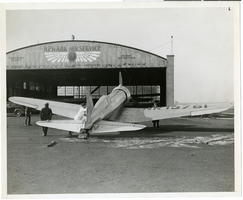
Photograph of Howard Hughes' Northrop Gamma Racer, Newark, New Jersey, January 1936
Date
1936-01
Archival Collection
Description
Black and white photograph of unidentified men positioning aircraft.
Image
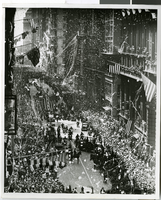
Photograph of Howard Hughes and his crew at a parade, New York, July 15, 1938
Date
1938-07-15
Archival Collection
Description
The black and white view of Howard Hughes and his crew at a parade after he completed his Round-The-World flight in New York. Handwritten on the back of the image: "B' way parade temporarily blocked by fire engines answering false alarm. 7/15/38."
Image
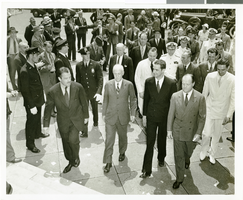
Photograph Howard Hughes arriving at City Hall, New York City, July 15, 1938
Date
1938-07-15
Archival Collection
Description
Typed onto a piece of paper attached to the image: "Howard Hughes and party arriving at City Hall. 7/15/38."
Image

Photograph of the landing of Howard Hughes' Lockheed 14 aircraft, New York, July 14, 1938
Date
1938-07-14
Archival Collection
Description
The black and white view of Howard Hughes' Lockheed 14 aircraft performing its final landing on the Round the World flight at Floyd Bennett Airport, New York. Typed onto a piece of paper attached to the image: ""The End of Hughes' Record-Smashing World Flight, New York City: Howard hughes' giant Lockheed taxiing down the runway at Floyd Bennett Field, July 14, at the end of the record-smashing flight around the world. The plane came to a rest at the field with Hughes and his picked crew of four just 3 days, 19 hours, and 14 minutes after it had taken off from the field on its flight around the world. Credit line (ACME). 7/14/38. IA For.""
Image

Photograph of Howard Hughes' Lockheed 14 airplane, circa late 1930s
Date
1935 to 1939
Archival Collection
Description
The black and white view of the Lockheed 14 airplane in flight.
Image
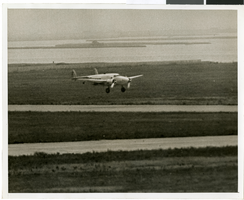
Photograph of the landing of Howard Hughes' Lockheed 14 aircraft, New York, July 14, 1938
Date
1938-07-14
Archival Collection
Description
The black and white, aerial view of Howard Hughes' Lockheed 14 aircraft performing its final landing on the Round the World flight in Floyd Bennett Airport, New York. Typed onto a piece of paper attached to the image: "Flight's End: Floyd Bennett Airport - Howard Hughes' silver monoplane, "World's Fair, 1939," as the skimmed the runway just before landing at 2:37 1/2 p.m., to end a dramatic dash around the world. A minutes later, Hughes and his companions were mobbed by officials. Credit (ACME). 7/14/38."
Image

Photograph Howard Hughes arriving at City Hall, New York City, July 15, 1938
Date
1938-07-15
Archival Collection
Description
Typed onto a piece of paper attached to the image: "Howard Hughes arriving at New York City Hall. 7/15/38."
Image
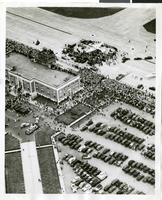
Photograph of the landing of Howard Hughes' Lockheed 14 aircraft, New York, July 14, 1938
Date
1938-07-14
Archival Collection
Description
The black and white, aerial view of Howard Hughes' Lockheed 14 aircraft after performing its final landing on the Round the World flight at Floyd Bennett Airport, New York. Typed onto a piece of paper attached to the image: "Aerial view of Hughes reception at Floyd Bennett Field. 7/14/38 (Press Association)"
Image
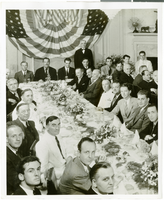
Photograph of a luncheon for the completion of Howard Hughes' Round the World flight, New York City, July 15, 1938
Date
1938-07-15
Archival Collection
Description
Typed onto a piece of paper attached to the image: "Fete, Hughes, and crew at Luncheon. Left to right at the head of the table are Harry P. Connor, navigator of the Hughes plane, Grover Whalen, Howard hughes, Mayor Fiorello Laguardia of New York City, Thomas Thurlow, Navigator, Richard Stoddart, radio engineer, and Edward Lund, flight engineer. At the bottom center of the photo is William Randolph Hearst, Jr., son of the publisher. 7/15/38"
Image
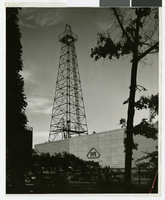
Photograph of the exterior of Hughes Research Laboratories, Culver City, California, circa 1940s
Date
1940 to 1949
Archival Collection
Description
The exterior of Hughes Research Laboratories where rock bits were test-drilled in Culver City, California in the 1940s. Transcribed from note taped to back of photo: "Rock bits are test-drilled in the laboratory under conditions that duplicate, as far as is possible in the laboratory, those encountered in actual drilling. As a result, rotational speeds, loads, and fluid volume are closely controlled. The rig operator occupies a splash-proof booth above the 'cellar floor.' The instruments on his control panel provide for application and measurement of variable axial loading on the drilling bit up to 100,000 lbs., variable rotational speeds up to 400 rpm, measurement of bit penetration over a total vertical travel of 5 feet at rates up to 180 ft. per hour, and torque. On the panel, also, are several controls for the operation of mud pump and other accessory equipment."
Image
Pagination
Refine my results
Content Type
Creator or Contributor
Subject
Archival Collection
Digital Project
Resource Type
Year
Material Type
Place
Language
Records Classification
